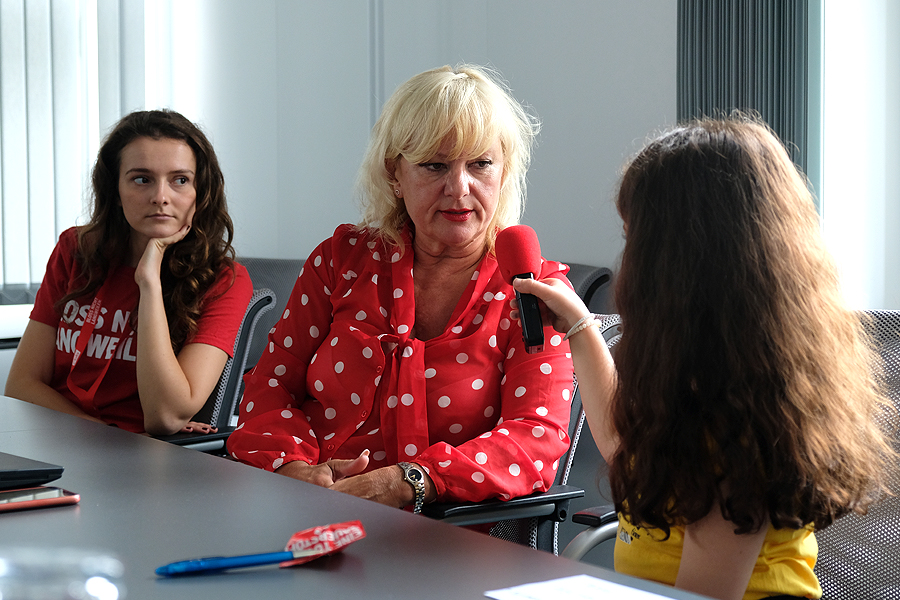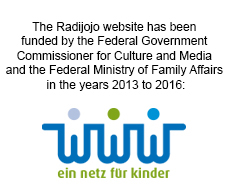
We are the Holiday Reporters Hala, Silina, Sidra, Joey, Malak, Abud and Ilayda and we visit the rbb today.
rbb is an acronym and stands for Rundfunk Berlin-Brandenburg. As such it is part of is part of ARD and thus belongs to the public service broadcasting. But what is public service broadcasting anyway? The so-called "public" include ARD, ZDF and all third party programs. And also the KiKa. Whereas tv stations such as RTL, ProSieben or Sat1 are commercially operated, so-called “private”.
The difference is that the "public" programs are financed for the most part by the television licence or broadcast receiving licence that is mandatory for every household in Germany. The “private” programs, on the other hand, are financed through advertising. Additionally public broadcasting has to fulfil special duties:
For example it is required to allow diversity of opinions, but also offer education, entertainment and advisory service.
At rbb we want to find out how the “big ones” do television and radio. And we want to know how news is selected and where journalists get their information from. For this we will meet later with Susanne Reinhardt. She is the duty manager at rbb-Inforadio.
But first we have an appointment with Anais Bockholt in the foyer. She will show us around the rbb today. Anais asks us to turn off our cell phones before we start. Because they could send signals and disrupt work here in the television center.
We are on our way to the studio of the “Abendschau”. Its first broadcast was back in 1958. On pictures in the corridor outside you can discover all the “Abendschau” hosts, from back then up until today.
Arriving at the studio we were amazed about the many spotlights under the ceiling. "They are needed so that the presenter of the evening show can be well lit" as Anais explains. We learn that it can get pretty hot when the spotlights are on.
There are a lot of big cameras in the studio. Some of them can not only transmit the television picture, they also have a special function: the anchorman and anchorwoman can read their text directly from the camera’s monitor. Such a device is also called a teleprompter (British: autocue).
Exactly where the show hosts usually stand and report on the most important news of the day from Berlin, today we can be the news anchors for a change.
After visiting the Abendschau, Anais leads us into an even larger studio. And we are amazed again! Over 160 spotlights hang here and they can be rotated in any direction as well. Each headlight has an individual number so that the lighting technician doesn't get confused..
Anais points to the wood paneling on the studio wall. “It's there so that the room also has good acoustics,” she tells us.
Many old radios can be found in the corridors of the rbb. In the age of smartphones and the Internet, it's hard to imagine, but our grandparents still listened to the radio with these huge devices.
Then we head over to the "Haus des Rundfunks". Radio is produced there. rbb 88.8, Kulturradio and Inforadio have their studios in the “House of Broadcasting”. In a stairwell we discover this strange elevator. It has no doors and travels through the floors without stopping. “It's a paternoster lift”, Anais explains.
There are many long corridors with numerous doors in the Haus des Rundfunks. And behind one of these doors you can find the studio of rbb 88.8 as well.
There are mixers, lots of microphones and monitors here. Anais explains to us how radio is produced here.
It will soon be 12:30 p.m. and every half an hour there is the news at rbb 88.8. The red lamp in the studio comes on. Now we have to be real quiet so that the news anchors are not disturbed. Because unlike the other rbb radio stations, the news is always spoken live here. We peer excitedly through the window.
And on through the atrium of the "Haus des Rundfunks" into a very special room. "Pay attention to what happens to your ears," Anais tells us on our way. And we feel it immediately: it feels very muffled inside the ears. Due to the insulation on the walls, the floor and the ceiling, the room has no (reverberant) sound. It feels a bit like being on an airplane, we realize. “It has to be like that,” Anais tells us, “because radio plays are produced here and for this it is important that the room has no acoustics.”
Anais shows us how to simulate sounds for a radio play. There are various wooden boxes under the carpet. They are filled with, for example, sand and pebbles. You can use it to imitate steps on different surfaces. Immediately we try out what that sounds like.
And then we visit the Inforadio. The Inforadio was the first digital radio in Germany and broadcasts news all day. Music is not played here. We have an appointment with Susanne Reinhardt, the duty manager. We want to know from her how journalists work here. "How do you choose the news, who determines that?" Sidra wants to know. "We have a very large editorial team and we decide a lot together," replies Ms. Reinhardt. And Hala wants to know: "Where do you get the information from and how do you know that it is factual?"
Malak is interested in what Susanne Reinhardt's working day looks like and Silina would like to know whether Inforadio also broadcasts something for children.

“Do you enjoy your work?” asks Joey.
And if you want to know what Ms. Reinhardt replied to all of our questions, then listen to our interview (window/ icon at the top).
After the interview we say goodbye to Susanne Reinhardt and Anais Bockholt and thank them for the great interview and the amazing tour inside the rbb. We all enjoyed it tremendously.
See you soon.

















